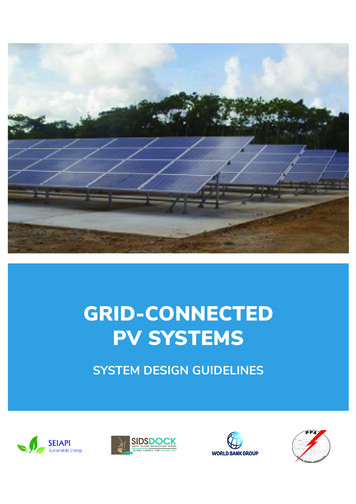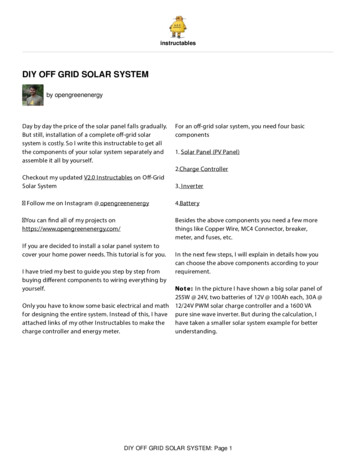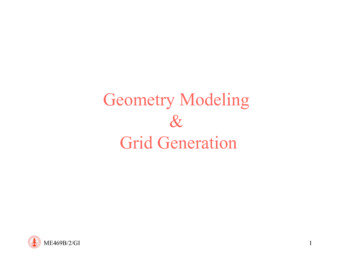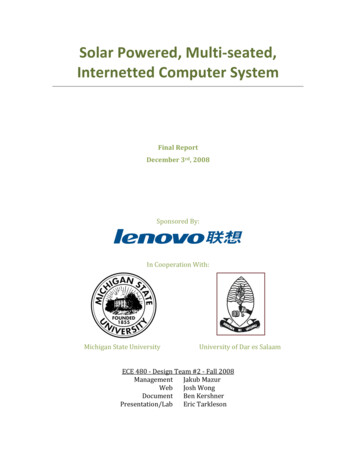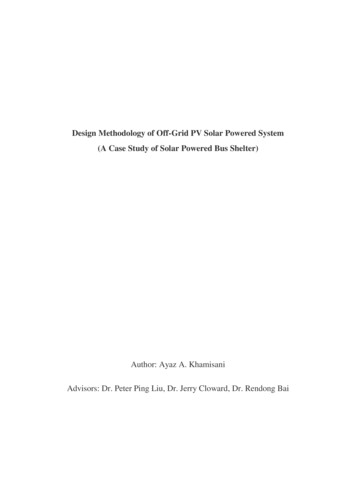
Transcription
Design Methodology of Off-Grid PV Solar Powered System(A Case Study of Solar Powered Bus Shelter)Author: Ayaz A. KhamisaniAdvisors: Dr. Peter Ping Liu, Dr. Jerry Cloward, Dr. Rendong Bai
DESIGN METHODOLOGY OF OFF GRID SOLAR SYSTEMSTable of contentPageList of figures03Abstract04Introduction05Photovoltaic Cells06Working Principle of Solar Panels07Principle07Types of PV Systems08Standalone or Off-Grid Systems09Integrated or Grid-Tied System10Methodology of Designing an Off-Grid PV System10Site assessment11Shed analysis11Sun Hour11Tilt Angle12Energy Calculations13Panel Sizing13Battery Sizing14Invertor14Charge Controller15Proposal to Convert 7th Street Bus Stand into a Standalone PV System.16Site Assessment17Calculating Energy Usage18Calculate Wattage of the Solar Panels19Battery Sizing19Invertor Sizing20Charge Controller Sizing20Conclusion20Reference222
DESIGN METHODOLOGY OF OFF GRID SOLAR SYSTEMSList of figuresPage1. Figure 1 working of solar cell:082. Figure 2 Off-Grid solar PV system093. Figure 3 Grid-tied PV system104. Figure 4 Sun hours across US125. Figure 5 7th street existing bus shelter176. Figure 6 CAD representation of the shelter183
DESIGN METHODOLOGY OF OFF GRID SOLAR SYSTEMSAbstractSolar energy has incredible potential to power our daily lives. Researchers suggest that theamount of sunlight that strikes the Earth's surface in an hour and a half is enough to handle theentire world's energy consumption for a full year.Solar power system is one of the best renewable energy technology which is not only costeffective but environment friendly as well. For my research, I have suggested methodologiesthat may be applicable to other off grid applications. I will be explaining design methodologyusing an example of an off-grid bus shelter. Off-grid or standalone systems can be defined asindependent systems that are not connected to any electrical grid. These come in different sizesand are mostly used in location where there is little access to grid infrastructure.The off-grid bus shelter project will completely depend on the solar energy i.e. solarphotovoltaics will harvest electricity to supply the devices such as lighting LED, Wi-Fi routerand advertising billboard. A battery backup would be used as a continuous power supply incase of the worst weather.This paper will focus on how methodology of off grid systems/stand-alone systems canhelp to reduce the dependency of grid and allow us to live in self-sufficient manners withoutreliance on one or more public utilities. Further, a PV system will be designed for a bus shelterat EIU to demonstrate the concept.4
DESIGN METHODOLOGY OF OFF GRID SOLAR SYSTEMSIntroductionEnergy is a necessity like food and water. Everything around us requires energy. Over the yearsthere has been an increase in the earth’s population which is directly proportional to the energyused as well. All the possible gadgets and equipment need some or the other kind of energy tofunction. With depleting fossil fuel reserves it becomes necessary to identify viable renewableenergy resources that can decrease the dependency on fossil fuels.Solar energy is the most abundant form of energy available to us. It is approximatedthat 10000 TW worth of solar energy is incident on earth’s surface in a day (Bosshard, 2006).According to a report, the world energy consumption in 2015 was 17.4 TW altogether (Seger,2016). There has been a minimal increase in the energy consumption every year,approximately 1-1.5% annual growth. The world’s total energy consumption is expected togrow by 56% by the year 2040 (U.S Energy Information Administration, 2013). Comparingcurrent consumption, projected growth in two decades, and the amount of solar radiationreceived in an hour we can just imagine the potential solar energy holds. The total energyconsumed is not small fraction of what we receive in an hour.Despite this energy potential available to us the current utilization of solar energy isless than 5% globally. There are countries that are taking initiatives to switch from using fossilfuels to solar applications. These countries form a pool called the G-20 countries which havetaken the global leadership to adopt renewable resources of energy. Germany is one of the G20 countries that has switched its energy needs to approximately 38% to solar, and aims to gocompletely stop its dependency on nuclear and replace it with solar by the year 2050(Richardson, 2017). Similarly, most of the countries have abundant solar potential and can takea lesson from Germany.5
DESIGN METHODOLOGY OF OFF GRID SOLAR SYSTEMSApart from harvesting the resource and decreasing the dependency on fossil fuelbecause they are limited, one must understand the consequences of using fossil fuels. Burningof fossil fuels for energy has an adverse effect on the environment. It releases CO₂ into theatmosphere which is responsible for the greenhouse effect. Further, it also causes the ozonelayer to be depleted. These mentioned phenomena can cause several events to occur such as;acid rain, air pollution, land pollution because of excavating operations, etc.A 4 KW solar panel used in homes for 25 years can offset 199,697 lbs of CO₂, is equivalent toplanting, and is equal to 208,166 (RGS- Rethink your roof, n.d.). It is fascinating that howmuch just one home can make an impact in the environment by using Solar panels. One couldimagine, what would be the benefit of using this technology on larger scale.Photovoltaic CellsIn the 18th century, Swiss physicists assembled a warm trap, which was a small-scalegreenhouse. He developed a hot box, by a glass box in another larger glass box, a total of up tofive boxes. When they are proposed to coordinate the sun illumination, the temperature in thedeepest box can be raised to 108 degrees Celsius; warm enough to soak water and cook food.These crates can be considered the world's first solar collection. In the late 1950, someorganizations and research facilities began to create a silicon based solar cell that considers thegoal of controlling Earth-orbiting satellites. These include RCA, Hoffman Electronics, and inaddition, the U.S. Army Alert Corps (Desideri, Zapparelli, & Garroni, 2013).A solar cell, or photovoltaic cell, is an electrical device that converts the energy ofphotons that are incident on it to electrical energy, which is a natural and synthetic marvel. Aseparate cell unit can be connected to a frame module, also known as a solar panel. Differentsolar cells in a unified set, all arranged in the plane represents a solar photovoltaic board or6
DESIGN METHODOLOGY OF OFF GRID SOLAR SYSTEMSmodule. PV modules usually have a glass in front of the panel, allowing light to pass through,while ensuring that the semiconductor plate is protected inside the case.Solar cells are usually associated, and arranged in series or parallel module, dependingupon the requirement of the customer. The parallel interface unit gets higher current; however,the problem, for example, that shadow effects can turn off weaker (less bright) parallel strings(different permutations of cells) can cause great unpleasant effects and may cause damagebecause of their enlightened complicity and the reversal of dark cell tendencies. A series ofstacked units are usually autonomous and not parallel, but starting from 2014, each moduleprovides a singular power box on a regular basis and connects in parallel.Working Principle of Solar PanelsIn the previous discussion it has been established that there is abundance of solar energyavailable to be harvested. A brief discussion of what PV cells is also being covered. It isnecessary that we understand how these cells generate electricity so that we can design systemsthat can be in tandem with these basic concepts. The following discussion will explain how thecells generate electricity.Principle: Sun is a powerhouse of energy and this energy moves around in the form ofelectromagnetic radiations. These radiations are of several types such as light, radio waves, etc.depending upon the wavelength of the radiations emitted. A very less percentage of sun’sradiations reach the earth’s atmosphere in the form of visible light. Solar cells use this visiblelight to make electrons. Different wavelength of light is used by different solar cells.Solar cells are made up of semiconductor materials, such as silicon, which is used to produceelectricity. The electricity is conducted as a stream of tiny particles called electrons and thestream is called electric current. Two main types of electric currents are; DC (direct current) in7
DESIGN METHODOLOGY OF OFF GRID SOLAR SYSTEMSwhich the flow of current is in the same direction while in AC (Alternating current) it mayreverse the direction of current. A typical solar cell has two layers of silicon, which is n-typeat the top and p-type at the bottom. When sunlight strikes the solar cell, the electrons areabsorbed by silicon, they flow between n and p-layers to produce electric current and thecurrent leaves the cell through the metal contact. The electricity generated is of AC type.Figure 1 working of solar cellTypes of PV SystemsWith growing demand for PV systems, the utilities provided an option for the consumers toconnect their systems to the grid. This step introduced a new term called “Net Metering.” Netmetering allows the consumers to send back the electricity they generate from their PV systemsto the grid. This is possible because of the grid-tied connection enabled by the utility. Similarly,we also have systems that are independent and do not require themselves to be connected tothe grid such systems are called off-grid systems or standalone systems. Both the systems havebeen explained in detail below:8
DESIGN METHODOLOGY OF OFF GRID SOLAR SYSTEMS1. Standalone or Off-Grid SystemsThe off-grid system term states the system not relating to the gird facility. Primarily, the systemwhich is not connected to the main electrical grid is term as off-grid PV system (Weis, 2013).Off-grid system also called standalone system or mini grid which can generate the power andrun the appliances by itself. Off-grid systems are suitable for the electrification of smallcommunity. Off-grid electrification system is viable for the remote areas in the countries wherethey do have little or no access to the electricity because of the distinct living and spreadpopulation in the vast area. The off-grid system refers to the support that would be adequatefor a living without depending on the grid or other system. Electrical energy in the off-girdsystem produced through the Solar photovoltaic panels needs to be stored or saved becauserequirement from the load can be different from the solar panel output, battery bank is alsoused for the purpose generally.Figure 2. Off-Grid solar PV systemThis project is considering the viability of having an off-grid PV system which can be usedto power a bus shelter. This concept can also be utilized on a larger scale to support all typesof homes which are in remote areas and where the cost of connecting cables and otherinfrastructure of electricity to the house is expensive.9
DESIGN METHODOLOGY OF OFF GRID SOLAR SYSTEMS2. Integrated or Grid-Tied SystemGrid connected photovoltaic power system is an electricity generating system which is linkedto the utility gird (energy.gov, n.d.). This photovoltaic system contains solar panel, inverterand the equipment to provide connection to the grid. Grid connected systems are feasible forvarious setup such as residential. Commercial and larger scale grid tied system different thanthe off grid solar power systems. Usually grid connected system does not need batterybackup, because when system generate the energy more than the load it will automaticallytransfer to the linked utility gird.Figure 3. Grid-tied PV systemIn the residential setups grid connected rooftop systems usually having the capability of 10kilowatts which could be enough to meet the house requirements, and the excess would feedthe grid which can be used by other consumers connected to the grid. The feedback or excesspower transfer system works through a meter to track the transferred power. In someinstances, PV system wattage could be less than the normal consumption due to severaldifferent factors and in this scenario, consumer will utilize the grid energy.10
DESIGN METHODOLOGY OF OFF GRID SOLAR SYSTEMSMethodology of Designing an Off-Grid PV SystemSite assessmentIn the introduction of solar photovoltaic (PV) clusters for private, commercial, or agriculturaloperations; a crucial idea is to determine the merits of the site (Franklin, 2017). Identifying theplace and position of the panels is a crucial step in designing a PV system as the latercomponents will be streamlined to this step. A few concepts and tips one must keep in mindwhile performing the site assessment are:1. Shade Analysis: Shading can be a problem for the solar panels as they decrease themaximum power that can be generated. Several factors contribute to this issue, the mostcommon cause of shade on a solar panel are; 1) Shade from neighboring trees andbuildings in vicinity, 2) typical cloudy weather, and 3) shade from adjacent solar panels(Solar Choice, 2016).While designing a solar PV system one must investigate these factors thoroughly sothat maximum output can be obtained. One of the tools most commonly used is solarpathfinder which gives the direction of the sun through out the year and how much anyspecific area will receive sunlight throughout the year (Solar Pathfinder, n.d.). Apartfrom having this tool, it is important that the site assessment is done properly to locatethe best site keeping in mind all the aspects.2. Sun hours: Sun hours are important to know how much radiance will be required togenerate the needed output wattage. This parameter gives us the knowledge of numberof hours an area will receive maximum sunlight (Franklin, 2017). With advances intechnology we have this data available online and anyone can use it. We have studiedthe data from NREL and NASA but for our project we will be using data given by11
DESIGN METHODOLOGY OF OFF GRID SOLAR SYSTEMSNREL as it is giving information of the Sun hours to a closer proximity to Charleston.The following chart gives the required information of the Sun hours depending ondifferent zones classified by NREL.Figure 4 Sun hours across U.S3. Tilt angle: Tilt angle is the setting of the panels one needs to have to get the maximumradiance. Ideally the tilt angle is the latitude of the geographic location. It is suggestedto have an adjustable panel frames as the sun hours keep changing with respect to thetilt in winters and summers. Hence for any area a specific tilt angle is calculated to getthe maximum radiance through out the year for a fixed panel. Also, it is advised to havethe panels facing the south to get the maximum afternoon sun. A couple of devices areused in the process of finding the tilt angle and the radiance that will fall upon panel atthat tilt angle are inclinometer and pyranometer, respectively.An inclinometer is kept on the panel and the degrees are read to find the latitude of thearea as it is perpendicular to the Sun’s radiations when it is at its highest point in thesky. Pyranometer measures the solar irradiance that will fall at a given tilt angle. Itmeasures solar irradiance in Watts per meter Sq. (W/m 2) (Franklin, 2017).12
DESIGN METHODOLOGY OF OFF GRID SOLAR SYSTEMSEnergy CalculationsThe consensus is to add wattage of the equipment that are going to be powered using the PVsystem. Alternatively, for this task we can use baseload calculators that are available on theinternet. We have used one such tool to calculate the baseload of our project, the following linkwill direct to the website which has the calculator (Wholesale solar , n.d.)Every device has fixed power consumption that can be found on its name plate details. Thisdata from all the devices that are going to be used should be retrieved. The website mentionedabove provides a table where this information needs to be entered. Other data that needs to beentered is number of each appliance that are going to be used and number of hours the applianceis supposed to remain ON. Up on filling the required data the website generates a table thatgive the total Watt-hours that are going to be used i.e. the total energy consumed or the wattageof the PV system.Another point one must pay attention to is the system voltage. It is required that the systemlevel chosen before we further probe into designing. Subsequent equipment designing wouldbe based on the system voltage level.Panel SizingOnce the total load to be energized using the PV system is calculated we must find out whatarea of solar panels would be required to generate that much amount of power. It is an inherentproperty of any panel to have internal losses. This factor should be kept in mind.As in the energy calculation we have already found the total watt-hours, for finding the wattageof panels that would be required we need to divide the total watt-hours with peak sun hours(Pelamis wave power, n.d.).13
DESIGN METHODOLOGY OF OFF GRID SOLAR SYSTEMSAnother useful tool that can be used is PV WATTS that helps use to calculate panel sizingjust by putting the parameters such as energy consumption, tilt angle, and Sun hour. We haveused this same website to calculate the solar panels. (NREL, n.d.)The website also enables the user to get the size of the panels that would be required to generatethe required wattage.Battery SizingPV battery system assesses various strategies from a financial perspective. The valuableexistence of the battery is limited to 5,000 cycles or in the planned living time of 20 years. Themaintenance of photovoltaic and rechargeable annual activities and expenditure systems is setat 1.5% per the speculative cost. Assume that the cost system for the battery and PV iscomparable to their size. Following is a formula that will enable to calculate what size of batterythey should have. (Leonics, n.d.)Battery Capacity (Ah) Total Watt-hours per day used by appliances x Days of autonomy(0.85 x 0.6 x nominal battery voltage)InverterInverter deals with following main tasks of energy: (ALTE store, n.d.) Convert DC from PV module to AC Ensure that the cycle of alternating current cycles is 60 cycles Reduce voltage variations Ensure that the condition of the AC waveform is suitable for the applicationMost system-connected inverters can be introduced externally, and most of the off-gridinverters are not weather-resistant. There are basically two types of grid intelligent Inverters:Those designed for batteries and those designed for systems without battery-connected invertersystems and give excellent void-quality strength. For matrix associations, the inverter shouldhave a "useful-interactive" typeface, which is printed specifically for the publication name.14
DESIGN METHODOLOGY OF OFF GRID SOLAR SYSTEMSGrid-connected systems measure the power of extracting PV clusters rather than a bunch ofprerequisite buildings. It asserts that what each power supply needs are what the matrix-relatedPV system can give naturally is drawn from the net.Invertors used for solar PV systems are usually based upon the total wattage of the solar panels,as the invertor will be continuously converting the power generated. The second considerationone must investigate, is the voltage level of the system. For example, if the system is designedto generate 2000 Watts at a voltage level of 12 V then the invertor selected should be rated12V, 2000 Watts (Alternative Energy, n.d.).Charge ControllerThe charge controller, sometimes referred to as a photovoltaic controller or charger, is onlynecessary for the system which involves a battery (Wholesale Solar, n.d.). The main capacityof the charge controller is to counteract the battery spoofing. The basic function of chargecontroller is to monitor charging and discharging of the battery. It prevents the battery frombeing completely charged or discharged. This is important because over charging can lead todestruction of the battery and under charging decreases the battery life. Another importantreason to use a charge controller is to prevent a reverse current flowing from battery to thesystem.There are two types of controllers that are widely available in the market; 1) Pulse widthModulation (PWM), 2) Maximum Power Point Tracking (MPPT) (Northern Arizon Wind andSun, n.d.)1. Pulse width modulation: A pulse width modulation charge controller is set match theinput power of the battery irrespective of the power generated by the panels. There isan inherent loss in power observed in this type of charger.15
DESIGN METHODOLOGY OF OFF GRID SOLAR SYSTEMS2. Maximum Power Point Tracking (MPPT): This type of charger helps to get theoptimum charging power for any given point of time and offers better efficiency thatPWM.Though the MPPT charge controllers enable you to have better efficiencies and provides morepower than compared to PWM for similar condition, the main cause of not opting for MPPT isprice of it (Solar Guy, 2016). MPPT charge controllers are more expensive than PWMcontrollers. Keeping this parameter in mind, this project will be using a PWM charge controllerfor realizing the concept. To select the size of charge controller one must know the voltagelevel of the system and the maximum operating current. It is a usual practice to over size thecontroller for safety reasons.Proposal to Convert 7th Street Bus Stand into a Standalone PV SystemBus shelters are common in every structure one can find in urban and sub-urban settings andmost of them are tied to the grid to provide electricity. But most of the rural and sub-urbanareas do not have this facility of having their bus shelters electrified through grid. In such placewe could use the off-grid or standalone PV system which can function without the gridsassistance.Eastern Illinois University has always been a leader in embracing new technologies thatpromotes betterment of the environment and its students. Panther shuttle bus-stops across thecampus serve hundreds of the students on a day-to-day basis. Currently, all the bus stops onthe campus are not connected with the existing electrical grid. Hence, taking an initiative toserve the students an also realizing a proof of concept for standalone systems the following PVsystem has been designed.16
DESIGN METHODOLOGY OF OFF GRID SOLAR SYSTEMSSite AssessmentFirst step in designing an off-grid bus shelter would be find a location to install the panels.Some factors that were taking into consideration while making a choice between variousoptions. More emphasis was given to the most used bus shelters, few of the bus shelters werefiltered out considered how often they were used. Secondly, a bus shelter with few surroundingstructures was a priority to avoid shading problem. For these reasons, 7th street bus shelter waschosen.Figure 5. 7th street bus shelterIn the above picture, it is visible that the roof of the shelter in shape of dome which will haveto be replaced to mount the panels on top. The next picture is of an AutoCAD drawing whichshows the dimensions of the shelter.17
DESIGN METHODOLOGY OF OFF GRID SOLAR SYSTEMSFigure 6 CAD representation of the shelterCalculating Energy ationWatts(V*A) Multi* 1.5Hours/dayHours/dayfor AC“from table”LED LightsNight use231480High Flux LEDNight use618141008Cell phone charger24 Hours use2515150WI-FI router24 Hours use12024480charger 24 Hours use11242424 Hours use112424SolarcontrollerSensorTotal Watt Hours per day1770.0018
DESIGN METHODOLOGY OF OFF GRID SOLAR SYSTEMS1770Wh/day 3 sun hours/day 590W590.W 0.8 (system losses) 737.5WWh 737.5W x 30 days Wh 22,125 Watt-hours (22.125 kWh/month)The project will be dealing with lower voltage devices hence a 12V system is chosen.Calculate Wattage of the Solar Panels1770Wh/day 3 sun hours/day 590W590W 0.8 (system losses) 737.5W737.5/250 2.95(3 Solar panels 250watts)For the project we would be using 3 panels of 250 Watts each.Battery SizingBattery Capacity (Ah) Total Watt-hours per day used by appliances x Days of autonomy(0.85 x 0.6 x nominal battery voltage)For this project, the daily average energy consumption per day is 1770 (W-h/day) for the monthof December.Battery Capacity (Ah) 1770 x 2(0.85 x 0.6 x 12) (1770/ (0.85x0.6x12)) x2 1770/0.85 2082.35 2082.35/0.6 3470.5 3470.5/12 289.2289.2x2 578.4578.4 Ah Battery Capacity required for the system19
DESIGN METHODOLOGY OF OFF GRID SOLAR SYSTEMSInvertor SizingAs explained previously that the invertor size should be based on the wattage and voltage levelof the system. This project employees a 12V and 2000W system, hence the invertor that shouldbe used should be of similar rating.Charge Controller SizingFor this project a PWM charge controller is to be used. Following steps will enable us to sizethe required charge controller.Voltage level of the system: 12VMaximum amperage: 10 AThere a PWM controller should be used with 12 V and 10 A with rated voltage and currentspecifications.ConclusionThere is a cost associated with electrifying houses in rural areas that increases with distancebetween the grid and the houses. Such instances where the cost of electrification becomesenormously highly one can always use an off-grid PV system. Both type of systems viz. gridtied and off-grid PV systems have their own advantages and disadvantages. Depending solelyon the need one can decide what they would want to go for. It is trend that one can observe isthat the grid-tied system is mostly found in urban and sub-urban setting where electrificationof the area has already been achieved. The off-grid system is more suited to areas where theelectrification is yet to be accomplished and/or the consumer choses not to supply back theenergy generated at his/her end.This paper provides the methodology of designing an off-grid PV system. Using a busshelter at EIU an PV system was designed that would house certain necessary equipment such20
DESIGN METHODOLOGY OF OFF GRID SOLAR SYSTEMSas WIFI module, charging points, lights, and sensors that would provide service to the studentswho would be using it. The design methodology is not limited to only bus shelters but couldalso be used for different purposes where ever a need of having an off-grid system arises.Economical aspect of the system has not been covered in this paper due to the availability ofnumerous vendors in the market. Upon identifying the system capacity, one can search the bestoption of different equipment depending on their financial preferences.21
DESIGN METHODOLOGY OF OFF GRID SOLAR SYSTEMSBibliographyALTE store. (n.d.). THE ROLE OF AN INVERTER IN A SOLAR ELECTRIC SYSTEM.Retrieved from ALTE store: erterin-a-solar-electric-system-a15/Alternative Energy. (n.d.). Solar Inverter Sizing. Retrieved from r/DIY/inverter-sizing.htmlBosshard, P. (2006). An Assessment of Solar Energy Conversion Technologies and ResearchOpportunities. Standford university. Retrieved from Stanford.edu.Desideri, U., Zapparelli, F., & Garroni, E. (2013). Comparative analysis of concentratingsolar power and photovoltaic technologies: Technical and environmental evaluations.Science Direct, 765-784.energy.gov. (n.d.). Grid-Connected Renewable Energy Systems. Retrieved from -connected-renewable-energy-systemsFranklin, E. (2017, August). Solar Photovoltaic (PV) Site Assessment. Retrieved fromCooperative s. (n.d.). How to design solar pv system. Retrieved from Leonics:http://www.leonics.com/support/article2 12j/articles2 12j en.phpNorthern Arizon Wind and Sun. (n.d.). All About Maximum Power Point Tracking (MPPT)Solar Charge Controllers. Retrieved from Northern Arizon Wind and rs.htmlNREL. (n.d.). NREL's PV Watt calculator. Retrieved from NREL: https://pvwatts.nrel.gov/Pelamis wave power. (n.d.). Solar Panel Size Guide: How Much Do You Need For YourHome? Retrieved from .pelamiswave.com: RGS- Rethink your roof. (n.d.). Head to Head: Benefits of Solar Energy vs Fossil Fuels.Retrieved from RGS: nal-power/Richardson, L. (2017, May 14). Solar electricity vs. fossil fuels: how do they compare?Retrieved from Energsage: -fuels/Seger, B. (2016, September 23). Global Energy Consumption: The Numbers for Now and inthe Future. Retrieved from LinkedIn: ption-numbers-now-future-brian-seger/Solar Choice. (2016, November 16). Why even partial shading is bad for solar powersystems. Retrieved from Solar Choice: -is-bad-for-solar-panels-powersystems/?nabe 4658498117042176:0&utm referrer https%3A%2F%2Fwww.google.com%2F22
DESIGN METHODOLOGY OF OFF GRID SOLAR SYSTEMSSolar Guy. (2016, April 7). Size your PWM Charge Controller With Our New Free SolarCharge Controller Calculator! Retrieved from SOLAR PANEL SECRETSEXPOSED: ller/Solar Pathfinder. (n.d.). Retrieved from https://www.solarpathfinder.com/PFU.S Energy Information Administration. (2013, July 25). EIA projects world energyconsumption will increase 56% by 2040. Retrieved from Today in p?id 12251Weis, C. (2013, January). Considerations for Off-Grid PV Systems. Retrieved from HomePower: https://www.homepower.com/articles/solar-electr
community. Off-grid electrification system is viable for the remote areas in the countries where they do have little or no access to the electricity because of the distinct living and spread population in the vast area. The off-grid system refers to the support that would be adequate for a livin


